Rocks have been used by mankind through out history. From the Stone Age rocks have been used for tools. The minerals and metals we find in rocks have been essential to human civilization.[1]
Three major groups of rocks are defined: igneous, sedimentary, and metamorphic. The scientific study of rocks is called petrology, which is an essential component of geology.
Contents |
Rock classification
See also: Formation of rocks
Rocks are generally classified by mineral and chemical composition, by the texture of the constituent particles and by the processes that formed them. These indicators separate rocks into three types: igneous, sedimentary, and metamorphic. They are further classified according to particle size. The transformation of one rock type to another is described by the geological model called the rock cycle.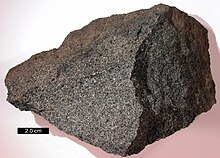
Sample of igneous gabbro
Sedimentary rocks are formed by deposition of either clastic sediments, organic matter, or chemical precipitates (evaporites), followed by compaction of the particulate matter and cementation during diagenesis. Sedimentary rocks form at or near the Earth's surface. Mud rocks comprise 65% (mudstone, shale and siltstone); sandstones 20 to 25% and carbonate rocks 10 to 15% (limestone and dolostone).[2]
Metamorphic rocks are formed by subjecting any rock type (including previously formed metamorphic rock) to different temperature and pressure conditions than those in which the original rock was formed. These temperatures and pressures are always higher than those at the Earth's surface and must be sufficiently high so as to change the original minerals into other mineral types or else into other forms of the same minerals (e.g. by recrystallization).[2]
The three classes of rocks—the igneous, the sedimentary and the metamorphic—are subdivided into many groups. There are, however, no hard and fast boundaries between allied rocks. By increase or decrease in the proportions of their constituent minerals they pass by every gradation into one another, the distinctive structures also of one kind of rock may often be traced gradually merging into those of another. Hence the definitions adopted in establishing rock nomenclature merely correspond to selected points (more or less arbitrary) in a continuously graduated series.[3]
Igneous rocks
Main article: Igneous rock
Igneous rock (derived from the Latin word igneus meaning of fire, from ignis meaning fire) forms through the cooling and solidification of magma or lava. Igneous rock may form with or without crystallization, either below the surface as intrusive (plutonic) rocks or on the surface as extrusive (volcanic) rocks. This magma can be derived from partial melts of pre-existing rocks in either a planet's mantle or crust.
Typically, the melting is caused by one or more of three processes: an
increase in temperature, a decrease in pressure, or a change in
composition. Over 700 types of igneous rocks have been described, most
of them having formed beneath the surface of Earth's crust. These have diverse properties, depending on their composition and how they were formed.Sedimentary rocks
Main article: Sedimentary rock
Sedimentary rocks are types of rock that are formed by the deposition of material at the Earth's surface and within bodies of water. Sedimentation is the collective name for processes that cause mineral and/or organic particles (detritus) to settle and accumulate or for minerals to precipitate from a solution. Particles that form a sedimentary rock by accumulating are called sediment. Before being deposited, sediment was formed by weathering and erosion in a source area, and then transported to the place of deposition by water, wind, ice, mass movement or glaciers which are called agents of denudation.Metamorphic rocks
Main article: Metamorphic rock
Metamorphic rocks arise from the transformation of existing rock types, in a process called metamorphism, which means "change in form". The original rock (protolith) is subjected to heat and pressure, (temperatures greater than 150 to 200 °C and pressures of 1500 bars[4]) causing profound physical and/or chemical change. The protolith may be sedimentary rock, igneous rock or another older metamorphic rock.Human use
The use of rocks has had a huge impact on the cultural and technological development of the human race. Rocks have been used by humans and other hominids for more than 2 million years.[5][not in citation given] Lithic technology marks some of the oldest and continuously used technologies. The mining of rocks for their metal ore content has been one of the most important factors of human advancement, which has progressed at different rates in different places in part because of the kind of metals available from the rocks of a region.[6][not in citation given]Mining
Main article: Mining
Mining is the extraction of valuable minerals or other geological materials from the earth, from an ore body, vein or (coal) seam. This term also includes the removal of soil. Materials recovered by mining include base metals, precious metals, iron, uranium, coal, diamonds, limestone, oil shale, rock salt and potash. Mining is required to obtain any material that cannot be grown through agricultural processes, or created artificially in a laboratory or factory. Mining in a wider sense comprises extraction of any non-renewable resource (e.g., petroleum, natural gas, or even water).Mining of stone and metal has been done since pre-historic times. Modern mining processes involve prospecting for ore bodies, analysis of the profit potential of a proposed mine, extraction of the desired materials and finally reclamation of the land to prepare it for other uses once the mine is closed.
The nature of mining processes creates a potential negative impact on the environment both during the mining operations and for years after the mine is closed. This impact has led to most of the world's nations adopting regulations to moderate the negative effects of mining operations. Safety has long been a concern as well, though modern practices have improved safety in mines significantly.
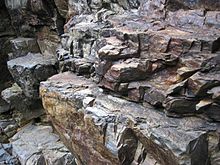

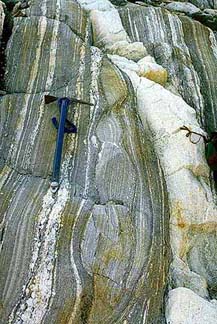
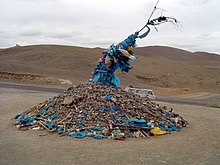
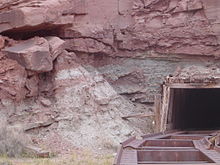
No comments:
Post a Comment